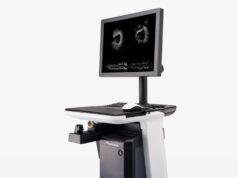
Researchers have shown that quiescent-inflow single-shot (QISS) magnetic resonance imaging (MRI) is able to identify more below-the-knee vessel segments than digital subtraction angiography (DSA) in patients with chronic limb-threatening ischaemia (CLTI). Taking first prize for best abstract, Alexander Crichton (Houston Methodist Hospital, Houston, USA and University of Birmingham, Birmingham, UK) shared this and other findings at the 39th European Society for Vascular Surgery (ESVS) annual meeting (23–26 September, Istanbul, Türkiye).
“Imaging patients with below-the-knee CLTI is challenging,” Crichton, who was presenting the research on behalf of Trisha Roy and colleagues at Houston Methodist, began. He cited the rise in diabetes and end-stage renal failure as two of the key reasons behind this, noting both cause calcified arterial disease that can “significantly” affect computed tomography (CT) and ultrasound imaging.
“Is digital subtraction angiography—our gold standard of current imaging—showing us what we need to see? Is it similarly affected by this calcium?” Crichton posed to the ESVS audience.
Regarding the available literature on the topic, the presenter referenced a study from the 1990s showing that non-contrast MRI could identify more patent vessel segments than DSA. He noted that this finding changed the researchers’ management of patients in 17% of cases. The problem was, however, that the technique was slow and marred by imaging artifacts. “It never really caught on,” Crichton remarked.
The presenter stated that clinicians now commonly use contrast-enhanced MRI. “But in 2025, do we need to?” he asked, citing newer, non-contrast MRI techniques, such as QISS MRI, that are fast, less affected by artifacts and “give a fantastic image”.
At Houston Methodist, Crichton shared, clinicians offer patients who require an MRI of their lower limbs a QISS MRI followed by a contrast MRI. In the present study, the researchers compared these patients’ QISS MRIs to their DSAs across 14 vessel segments.
The primary outcome of the study was to assess whether QISS MRI could identify more patent vessel segments than DSA, with the secondary outcome being the effect of QISS MRI versus DSA on disease severity scores, namely Trans-Atlantic Inter-Society Consensus (TASC) and Global Limb Anatomic Staging System (GLASS) scores.
In total, the researchers compared QISS MRI to DSA across 752 vessel segments in 56 patients.
Crichton reported that the median time from QISS MRI to DSA was short, at around four days, and that the number of patent vessel segments on QISS MRI was an average of 10% higher than that on DSA, which he detailed was a statistically significant difference.
In addition, Crichton revealed that the difference in the number of visible vessels on QISS MRI compared to DSA became more pronounced the further down the limb the imaging was used. He cited a statistically significant difference of over 30% at the level of the dorsalis pedis artery, for example.
The presenter also noted a “knock-on effect” on both TASC and infrapopliteal GLASS scores. “The mean TASC score and the mean infrapopliteal GLASS score were significantly downgraded when we used QISS MRI to evaluate these arteries,” he said. “This is really important, because this is our language to classify disease severity. It’s what we’ve used in the most recent SWEDEPAD trial.”
To demonstrate the clinical implications of the researchers’ finding, Crichton cited a case example involving the search for a patent dorsalis pedis artery that did not show on DSA, but did on QISS MRI, with the QISS MRI also revealing a patent distal anterior tibial artery. “This changes how we manage this patient. I believe that this gives you more options to treat it,” he commented.
Sharing his take-home messages, Crichton summarised that QISS MRI identifies more arterial segments than DSA, with the difference between the two imaging modalities becoming increasingly significant the further down the limb they are used. He reiterated that QISS MRI also affects both TASC and infrapopliteal GLASS scoring, downgrading both. “But most importantly,” he said in closing, “I truly believe that this could change how we manage our patients. This is easy to integrate into our practice, and I think we could use it a lot more.”











